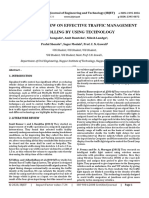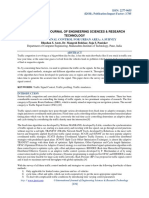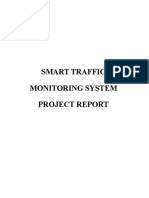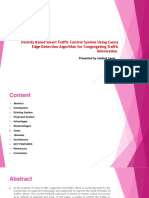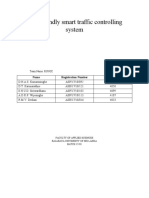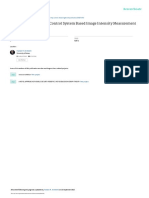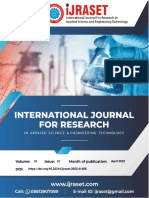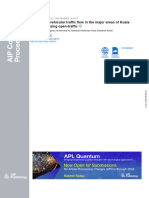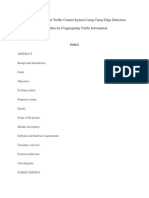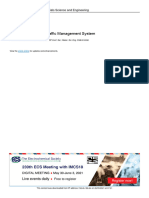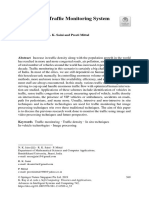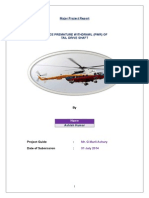5 - Study of Automatic Traffic Signal System For Chandigarh PDF
5 - Study of Automatic Traffic Signal System For Chandigarh PDF
Uploaded by
ईशान्त शर्माOriginal Description:
Original Title
Copyright
Available Formats
Share this document
Did you find this document useful?
Is this content inappropriate?
Report this DocumentCopyright:
Available Formats
5 - Study of Automatic Traffic Signal System For Chandigarh PDF
5 - Study of Automatic Traffic Signal System For Chandigarh PDF
Uploaded by
ईशान्त शर्माCopyright:
Available Formats
[Sharma, 4(7): July, 2015] ISSN: 2277-9655
(I2OR), Publication Impact Factor: 3.785
IJESRT
INTERNATIONAL JOURNAL OF ENGINEERING SCIENCES & RESEARCH
TECHNOLOGY
STUDY OF AUTOMATIC TRAFFIC SIGNAL SYSTEM FOR CHANDIGARH
Ishant Sharma *, Dr. Pardeep K. Gupta
*
Civil Engineering Department, PEC University of Technology, India
Civil Engineering Department, PEC University of Technology, India
ABSTRACT
The increasing number of vehicles on our road intersections has given rise to the problems like road accidents,
congestions, conflicts and bottlenecks. These problems can now only be solved by providing an efficient traffic control
at intersections and that can be achieved by provision of automated volume based traffic signal system at intersections
for continuous and efficient movement of vehicles through the intersections
Chandigarh the city beautiful though a modern and well planned city, is also facing the same traffic problems.
Here, the present traffic signals are based on the static feed of time without considering the actual available traffic.
This leads to a situation where vehicles wait unnecessarily in one of the lanes while the traffic flow is not up to the
considerable amount in the other lane. This paper provides the feasibility of replacing existing traffic signals with a
system to monitor the traffic flow automatically in traffic signals where sensors are fixed in which the time feed is
made dynamic and automatic by processing the live detections.
The paper deals with the feasibility of provision of inductive loop detection based traffic signals in place of existing
pretimed traffic signals by comparing their performance, suitability and economics.
KEYWORDS: Traffic Control, Inductive loop Detector, PCU, Automatic Traffic Control, Intersection, Traffic Field
Studies.
INTRODUCTION placement of automatic traffic signals at the
Intersections are important part of a road section. intersections to enable the efficient traffic control of
When provided without any proper traffic control traffic and also the faster clearing off the traffic from
measures they end up with congestion and the intersection.
bottleneclks. So, to prevent this issue, these should be Along the Madhya Marg, starting from PGI there
designed on the aim of decreasing It has been observed are11 intersections [4] up to Housing Board Chowk
during this study that many intersections in among them 5 have been converted into signalized
Chandigarh have become inadequate to handle the intersections and 6 are converted into rotaries. The
present day traffic causing congestion [2], signalized intersections are based on fixed time traffic
delays,bottlenecks and accidents particularly during signal system. In this paper, existing traffic conditions
the peak hours as the traffic control system installed at one of the major intersections of Madhya Marg i.e.
on these intersections are pretimed. Transport Chowk was examined and traffic volumes
The efficiency of traffic control at the intersection can and speed data were taken accordingly. The signal
now only be improved by the provision of automatic timings for pretimed traffic signals were redesigned by
traffic signal system which works on real-time making use of Websters/ IRC method and also
detections and eliminates the wastage of green time automatic traffic signals were designed and these both
allotted to a phase. were compared for in terms of their performance and
Madhya Marg is one of the most important roads in economy.
Chandigarh as it connects P.G.I. to Panchkula [1]. In
addition to this, it also provides access to many LITERATURE REVIEW
educational institutes, shopping centers, restaurants, Vidhya & Banu [9] (2014) designed a project to
corporate offices, grain market etc. It is also the only develop a density based dynamic traffic signal system.
route for the traffic moving towards Shimla & Kalka. The project consisted processing of image captured in
So due o the above constraints, its consideration for the traffic signal and then it was converted to grayscale
research works has been arosen which deals with the
http: // www.ijesrt.com International Journal of Engineering Sciences & Research Technology
[26]
[Sharma, 4(7): July, 2015] ISSN: 2277-9655
(I2OR), Publication Impact Factor: 3.785
image and after that to calculate the number of The figure 1 shows the existing layout of Transport
vehicles contorurs were drawn to have its threshold. Chowk Intersection and all the dimensions are in
Calculation of number of vehicles gave the density meters.
which was further used for allocating green time to the
traffic on the approach lane by using the Raspberry pi
as a microcontroller.
Karthick et al [10] (2012) proposed a system to analyse
the live video camera recordings to handle the traffic
automatically by allotting green time to the traffic by
calculating the number of vehicles which gives the
traffic density which acted as a input for the algorithm
which was in place for allocating optimal time for the
vehicles to pass the intersection.
Khiang Tan et al [12] (1996) developed a graphical
simulation windows software for the design and
implementation of an automatic traffic lights
controller by making use of fuzzy logic technology
and also compared the designed software results with Figure 1 Existing layout of Tansport Chowk Intersection
conventional lights controller in which the desgned
one was found to be superior in terms of performance Instruments/Gadgets Used
and cost. 1. Sony Handy Cam
Rekha & Karthika [15] (2013) presented a combination 2. Smartphones
of inductive loop sensors and fuzzy logic technology 3. Power Bank
in which inductive loop sensors were responsible for 4. Radar Gun
real-time traffic data and fuzzy logic technology was
responsible for the allotment of green time to the Methods Used:
traffic to clear off the intersection efficiently. This 1. Traffic Volume Study
method was proved to be very effective in handling the 2. Traffic Speed Studies
traffic
Rashid Hussain et al [16] (2013) proposed the concept
INTERSECTION
of Wireless sensor network technology have the real-
time traffic data at an intersection and then to allocate VOLUME
the timings to the traffic to clear off the intersection. COUNTS
This method was proced to be efficient as it didnt
required any built in system in vehicles for its
working.
Shilpa et al [19] (2009) worked on a new technique
Intelligent traffic light controller which was made
by making use of GSM services as it included
providing the information regarding traffic flow to
users by sending SMSs in addition to the sensors
provided on the intersection to allocate the timings to
clear off the intersection. This system was compared
with ficed traffic signals and found to be more
efficient. Figure 2 Location of Traffic Volume Counts
A video of the traffic at Transport Chowk shown in
INSTRUMENTS & METHODS figure 2 was recorded for the duration of continuous
Methodology 12 hours i.e. 8:00 AM to 8:00 PM in order to have the
In present study, firstly, Traffic field studies is used to entire day traffic data [17] and also to identify the peak
have the traffic volume and speed data of the Transport and off peak hours for the traffic flow.
Chowk Intersection which are used as input for the Traffic speed studies was done on the mid-block
redesign of pretimed traffic signals [8] by Websters section each approach lane of the junction by use of
and IRC method and also for the design of automatic Radar gun by taking 50 -100 observations [11] in the
traffic signals. input data.the variation in speed of traffic at all the four
legs is shown in figure 3,4,5 and 6.
http: // www.ijesrt.com International Journal of Engineering Sciences & Research Technology
[27]
[Sharma, 4(7): July, 2015] ISSN: 2277-9655
(I2OR), Publication Impact Factor: 3.785
player on laptop by slowing the playback speed in
order to find out the peak hour flow by converting the
vehicles into the PCU i.e. Passenger Car Unit by
making use of the PCU Factors [5] given in table 2
Figure 3 Variation in Speed of traffic in leg 1
Figure 6 Variation in Speed of traffic in leg 4
Table 1. Perecentile Speeds
Approach Lane Percentile Speed
(KM/H)
98th 85th 50th 15th
From PGI 68 52 38 27
From Grain 44 34 24 19
Market
From Housing 68 52 38 28
Figure 4 Variation in Speed of traffic in leg 2 Board
From Industrial 63 50 38 27
Area
Table 2. PCU Factors used for traffic signal design
[5]
Vehicle PCU Factor
Car 1
2W 0.5
3W 1
Bus/Truck 3
Cycle 0.5
Figure 5 Variation in Speed of traffic in leg 3 Rickshaw 1.5
LCV 1.5
Table 1 shows the percentile speeds of all the approach Horse Drawn 4
lanes of Transport Chowk Intersection which are Tractors 4.5
found out from cumulative frequency distribution
curves made from the data collected by making use of
the radar gun.[11] From the figure 7, the peak hour was found to be
From the traffic volume studies, videos are counted for between 9.15-10.15 hours as 7046 PCU/hr. Figure 8
15 minute interval [17] for each 4 hours i.e. 8:00 -12:00, shows the composition of traffic in the entire day and
12:00 16:00 and 16:00 20:00 Hrs on vlc media gives the idea of the traffic being heterogeneous.
http: // www.ijesrt.com International Journal of Engineering Sciences & Research Technology
[28]
[Sharma, 4(7): July, 2015] ISSN: 2277-9655
(I2OR), Publication Impact Factor: 3.785
by making use of websters method cycle time is
designed.
Pretimed Traffic Signals
A four phase signal system was designed for the
intersection by making use of Websters method for
signal design and IRC method for the minimum time
for pedestrian crossing.[6]
As the slip roads are already been provided at the
intersection left turns are not included in the signal
design and only right turning movements and straight
traffic is included.[11]
The Transport Chowk is shown in figure 10 and four
phases taken into design consideration are:[8]
Phase 1: Straight & Right movement for lane 1
Figure 7 Variation of Traffic in Entire Day4 Phase 2: Straight & Right movement for lane 3
Phase 3: Straight & Right movement for lane 4
Phase 4: Straight & Right movement for lane 2
Figure 8 Composition of Traffic in Entire Day
Figure 10 Study Area
Pretimed signals are designed by making use of the
websters method of signal design and IRC method.
Websters method gives the optimum cycle length
whereas the IRC method gives the minimumgreen
time on the basis of time taken by pedestrians to cross
the approach lanes.[13]
1.5L+5
Co = (1)
1y
Figure 9 Traffic Flow Diagram for the Peak Hour Flow Where, Co is optimum cycle time, L is lost time and
y = sum of maximum present flow to saturation flow
Figure 9 shows the turning movements of traffic ratios of all the phases.
during peak hour and all the figures are in PCU i.e.
Passenger Car Unit. Automatic Traffic Signals
The pretimed traffic signals and automatic traffic These are designed by on the basis of their working
signals were designed for this peak hour flow. principle i.e. minimum green time, unit extension or
passage time, maximum green time. The phases are
http: // www.ijesrt.com International Journal of Engineering Sciences & Research Technology
[29]
[Sharma, 4(7): July, 2015] ISSN: 2277-9655
(I2OR), Publication Impact Factor: 3.785
same as taken in the pretimed signal design. Operating Where, A is the projected traffic volume, P is the
principle of these traffic signals include firstly volume count of the available year or current year,r is
allotment of green time for a minimum time which is the rate of growth of traffic per year usually taken as
independent of any detections of vehicles and will 0.075 [7] and n is number of years.
occur in each cycle. The minimum green may be taken The peak hour traffic is generally 8- 10% of the
according to the IRC recommendations or on the Average Daily Traffic (ADT), hence from the above
number of vehicles to be passed or can also be fixed table, by assuming 9 % the ADT may be taken as
by fixing the location of detector from stop line [14].The 78300 PCU/Day.
automatic signals designed in this study are based on
point detection. So minimum green time is given by: Capacity of Intersection
Gmin = t L + [h integer (dx)] (2) By making use of the formula given below the
capacity of a lane for the both pretimed and automatic
Where,Gmin = minimum green time in second, tL = traffic signals can be computed as, [3]
assumed start-up lost time = 4 sec, h = assumed g
ci = si Ci (4)
saturation headway = 2 sec, d = distance between
detector & stop line in m and x = assumed distance Where ci is the capacity of lane in vehicle per hour, si
between stored vehicles = 6 m. is the saturation flow rate in vehicle per hour per lane,
Secondly, Unit Extension time is given to the phase if gi is the effective green time alloted to the lane in
any vehicle is detected by the detector.it is also know seconds and C is the cycle time in seconds.
as passage time i.e. time required by the vehicle to By combining the capacity of all the approach lanes
cross the distance between detector and stop line and we get the capacity of intersection.
is given by:
P = (d/S) (3) Level of Service
Where, P = passage time, sec, d = distance from By making use of the capacity of each approach lane
detector to stop line, meter and S = approach speed of intersection level of service for each lane is calculated
vehicles, m/s. (15th Percentile speed) by dividing the present traffic volume by the capacity
Thirdly, the minimum green time is extended to the and LOS can be read from the figure 12. [11]
maximum green time which is found out by increasing
the cycle length obtained in pretimed signal operation
by 150 percent.
Figure 11 shows the opeating principle of an automatic
traffic signal.
Figure 12 Level of Service
Figure 11 Operation of an automatic traffic signal
RESULTS AND DISCUSSION
The inductive loop detectors culd be used to have the Figure 13 shows the phase diagram for the pretimed
real-time traffic data or to detect the vehicles in case signal operation which gives the designed cycle length
of automatic traffic signals. and allotted green time for different phases and amber
times for the same.
Future Traffic Prediction
Also the peak hour so found is then further used to
predict the growth of traffic in next 10 years.The
formula applied for calculations of the projected traffic
volume for the next ten years is as [7]
= ( + )
http: // www.ijesrt.com International Journal of Engineering Sciences & Research Technology
[30]
[Sharma, 4(7): July, 2015] ISSN: 2277-9655
(I2OR), Publication Impact Factor: 3.785
From 2993 B 3129 B
Industrial
Area
From the above table 3 it can be seen that the capacity
is increased in case of automatic traffic signals and
Level of Service is also improved, so as far as capacity
part is concerned Automatic traffic signals are better
than pretimed traffic signals.
As far as waiting time is concerned, as automatic
signals work on real-time detections by making use of
inductive loop detector technology, the waiting time of
Figure 13 Phase diagram for Pretimed traffic signals
the vehicles is lesser than that of in case of pretimed
traffic signals.
Wasted time is almost negligible in case of Automatic
traffic signals as the real-time detection of absent
traffic will give the green time to the next phase. In
case of pretimed traffic signals timings are fixed and
lot of time is wasted when there is no traffic on the lane
to which green time is allotted.
It was seen that automatic traffic signals are expensive
than the pretimed traffic signals by a margin of Rs.
2,10,000 but as these give more performance than the
pretimed traffic signals in terms of capacity and time
saving these can be installed at the Transport Chowk
intersection.[18]
CONCLUSION
Figure 14 Phase diagram for Automatic traffic signals It can be concluded that the by replacing the pretimed
traffic signals with the automatic traffic signals,
Figure 14 shows the phase diagram for automatic capacity is being increased and LOS is also being
traffic signals and gives the designed cycle length, improved.Detector technology to be used for the
minimu green time, maximum green time and amber detection of vehicles is Inductive loop which is
time of all the phases. All the figures are in seconds. commonly used and simple to install, operate and
maintain. When pretimed traffic signals fail to clear
Table 3. Comparison of Pretimed and Automatic off the intersection traffic police have to clear off the
Traffic Signals intersection by turning off the traffic signals and
handling the traffic manually on their own. This
Approach Pretimed Automatic problem can be solved by placing automatic traffic
Lane Signals Signals signals. As automatic signals are saving the wasted
time and increasing the capacity the expensive part can
Capacity LOS Capacity LOS
be tolerated and hence they can be provided at
PCU/hr PCU/hr Intersection. After 3 years Websters method of signal
design fails to design the signal for the traffic as the
From PGI 2516 F 2651 E value of Y comes greater than 1. So at this situation
automatic traffic signals comes into play as they will
From 1116 E 1182 D be detecting real-time traffic and assigning the green
Grain time for the approach lanes to clear off the traffic.
Market
ACKNOWLEDGEMENTS
From 1755 F 1835 F We are grateful to the project co-ordinator, HOD and
Housing staff of mechanical engineering department, PEC
Board University of Technology, Chandigarh for giving us
the opportunity to work on this project and for guiding
http: // www.ijesrt.com International Journal of Engineering Sciences & Research Technology
[31]
[Sharma, 4(7): July, 2015] ISSN: 2277-9655
(I2OR), Publication Impact Factor: 3.785
us throughout our research work. We are also thankful Malaysian Journal of Computer Science,
to SSP Traffic Police Department, Chandiagrh for volume 9, Issue 2, pp. 29-35.
providing the permissions and facilities necessary for [13] N.P.T.E.L. (nptel.ac.in/courses/105101008)
completion of our research work. Special thanks to our
Design principles of traffic Signal Chapter
family and friends for supporting us throughout our
work. 34, Traffic Engg. Management, April 02,
2012.
REFERENCES [14] Tom V. Mathew, Transportation
[1] Chandigarh Administration, Chandigarh Engineering I, Transportation Systems
Master Plan 2031. Engineering, Civil Engineering Department,
[2] Chandigarh traffic Police. Black Book India Institute of Technology Bombay, 2006.
2014. [15] R. Rekha and R. Karthika, June 2013, Fuzzy
[3] Dr. Bhargab Mehta, Introduction to Based Traffic Congestion Detection &
Transportation Engineering, Department of Pattern Analysis Using Inductive loop
Civil Engineering, IIT Kharagpur. Sensor, International Journal of Scientific &
[4] Finance Secretary (Chandigarh Engineering Research ISSN: 2229-5518,,
Administration), City Plan Development Volume 4, Issue 6, pp. 1149-1152
Plan Chandigarh, JNNURM, Govt. of India. [16] Rashid Hussain, Sandhya Sharma,Vinita
[5] Indian Road Congress IRC SP 41, Sharma and Sandhya Sharma, July 2013,
Guidelines on design of At-grade WSN Applications: Automated Intelligent
intersections in rural and urban areas IRC Traffic Control System Using Sensors,
New Delhi. International Journal of Soft Computing and
[6] Indian Road Congress IRC -93:1985, Engineering (IJSCE) ISSN: 2231-2307,
Guidelines on design on installation of road Volume 3, Issue 3, pp. 77-81.
traffic signals. IRC New Delhi. [17] Robertson, H. D. 1994. Volume Studies. In
[7] Indian Road Congress IRC -108:1996, Manual of Transportation Engineering
Guidelines for Traffic prediction on Rural Studies, ed. H.D. Robertson, J. E. Hummer,
highways IRC New Delhi. and D. C. Nelson. Englewood Cliffs, N.J.:
[8] Pardeep K. Gupta and Ishant Sharma,April- Prentice Hall, Inc., pp. 631.
June 2015, Study of Traffic Flow in an [18] RR Electronics (an RR Group Co), SCO
Entire Day at a Congested Intersection of 181/22, Industrial Area Phase I, Chandigarh
Chandigarh, Journal of Civil Engineering [19] Shilpa S. Chavan, Dr. R. S. Deshpande and
and Environmental Technology ISSN : 2349- J.G. Rana, 2009, Design of Intelligent
8404,Volume 2, Number 12, pp. 70-73. Traffic Light Controller using embedded
[9] K. Vidhya and A. Bazila Banu, March 2014, system, Proceedings of the Second
Density Based Traffic Signal System, International Conference on Emerging
International Journal of Innovative Research Trends in Engineering and Technology, pp.
in Science, Engineering and Technology, 1086-1091.
Volume 3, Special Issue 3, pp. 2218-2222.
[10] Karthick S, Deeban B and S. Abirami, March
2012, Automated Traffic Signal Prediction
from Surveillance Videos, International
Journal of Computer Applications, Volume
42, issue 1, pp. 41-45.
[11] Khanna, Justo. Highway Engineering,
Nem Chand & bros. Roorkee, 2005.
[12] Kok Khiang Tan, Marzuki Khalid and
Rubiyah Yusof, December 1996, Intelligent
Traffic lights control by fuzzy logic,
http: // www.ijesrt.com International Journal of Engineering Sciences & Research Technology
[32]
[Sharma, 4(7): July, 2015] ISSN: 2277-9655
(I2OR), Publication Impact Factor: 3.785
AUTHOR BIBLIOGRAPHY
Ishant Sharma
M.Tech Scholar in Tranportation
Engineering
PEC University of Technology,
Chandigarh
Dr. Pardeep K. Gupta
Associate Professor
Civil Engineering Department
PEC University of Technology,
Chandigarh
http: // www.ijesrt.com International Journal of Engineering Sciences & Research Technology
[33]
You might also like
- Study of Automatic Traffic Signal SystemDocument8 pagesStudy of Automatic Traffic Signal Systemkunwar.gecNo ratings yet
- Paper 8871Document6 pagesPaper 8871IJARSCT JournalNo ratings yet
- PDF Updated Literature Review Paper PDFDocument4 pagesPDF Updated Literature Review Paper PDFSagar Modak0% (1)
- Density Based Smart Traffic Control System Using Canny Edge DetectionDocument10 pagesDensity Based Smart Traffic Control System Using Canny Edge DetectionIJRASETPublicationsNo ratings yet
- Intelligent Traffic Monitoring System: July 2015Document12 pagesIntelligent Traffic Monitoring System: July 2015Mrunal JanbandhuNo ratings yet
- Dynamic Traffic Light Algorithm Incorporating Post-Intersection Space AllocationDocument8 pagesDynamic Traffic Light Algorithm Incorporating Post-Intersection Space AllocationInternational Journal of Innovative Science and Research TechnologyNo ratings yet
- 53 - Traffic Signal Control For Urban Area A Survey PDFDocument6 pages53 - Traffic Signal Control For Urban Area A Survey PDFMuhammad Faisal Habib JanjuaNo ratings yet
- Intelligent Traffic Monitoring System PDFDocument11 pagesIntelligent Traffic Monitoring System PDFMary BakhoumNo ratings yet
- Real-Time Traffic Management SystemDocument8 pagesReal-Time Traffic Management SystemIJRASETPublicationsNo ratings yet
- Advanced Traffic Light Controller System Using FPGA ImplementationDocument10 pagesAdvanced Traffic Light Controller System Using FPGA ImplementationIJRASETPublicationsNo ratings yet
- A Simple Method For Estimation of Queue Length: Digitalcommons@University of Nebraska - LincolnDocument6 pagesA Simple Method For Estimation of Queue Length: Digitalcommons@University of Nebraska - LincolnAltaf HossainNo ratings yet
- Detection of Humps and Potholes On Roads and Notifying The Same To The DriversDocument4 pagesDetection of Humps and Potholes On Roads and Notifying The Same To The Driversdhanu suriyaNo ratings yet
- Reviewpaperof TLCSDocument5 pagesReviewpaperof TLCSAnuja WaghNo ratings yet
- Smart Traffic Monitoring System Project ReportDocument25 pagesSmart Traffic Monitoring System Project ReportGaming4LifeNo ratings yet
- E3sconf Gcee2023 01004Document8 pagesE3sconf Gcee2023 01004REMYA Y.KNo ratings yet
- Hardwarex: Tian Lei, Abduallah A. Mohamed, Christian ClaudelDocument12 pagesHardwarex: Tian Lei, Abduallah A. Mohamed, Christian ClaudelIlham Nur AziziNo ratings yet
- A Simulation-Based Study For The Optimization of Toll Plaza With Different Lane Configuration A Case Study of Ravi Toll Plaza Lahore, PakistanDocument9 pagesA Simulation-Based Study For The Optimization of Toll Plaza With Different Lane Configuration A Case Study of Ravi Toll Plaza Lahore, PakistanShakir AhmadNo ratings yet
- Intelligence Traffic Control SystemDocument24 pagesIntelligence Traffic Control Systemsuliat ikudaisiNo ratings yet
- Traffic ManagementDocument12 pagesTraffic ManagementTanisha BhattNo ratings yet
- Paper TR31 0610045112Document11 pagesPaper TR31 061004511201,CE-11th Tasneem Ahmed ShuvoNo ratings yet
- Intelligent Road Traffic Control System For TraffiDocument9 pagesIntelligent Road Traffic Control System For TraffiSimona NicoletaNo ratings yet
- An Iot Based Intelligent Traffic Congestion Control System For Road CrossingsDocument5 pagesAn Iot Based Intelligent Traffic Congestion Control System For Road CrossingsAli ZafarNo ratings yet
- Modeling of Traffic Light Control Using Labview: December 2017Document5 pagesModeling of Traffic Light Control Using Labview: December 2017Alex ZXNo ratings yet
- Its Implementation and Evaluation byDocument6 pagesIts Implementation and Evaluation bySureshNo ratings yet
- Smart Traffic Management Using Deep LearningDocument3 pagesSmart Traffic Management Using Deep LearningInternational Journal of Innovative Science and Research TechnologyNo ratings yet
- nsdr12 Final2 PDFDocument6 pagesnsdr12 Final2 PDFLara SteinNo ratings yet
- Smart Traffic Congestion Learning Model For Dynamic Emergency Vehicle Routing Using (DCN) Deep Cross Network PDFDocument4 pagesSmart Traffic Congestion Learning Model For Dynamic Emergency Vehicle Routing Using (DCN) Deep Cross Network PDFInternational Journal of Innovative Science and Research TechnologyNo ratings yet
- Density Based Traffic Control Using Image Processing Methods A ReviewDocument4 pagesDensity Based Traffic Control Using Image Processing Methods A ReviewInternational Journal of Innovative Science and Research TechnologyNo ratings yet
- Ausmt 2023 13 01 2464Document11 pagesAusmt 2023 13 01 2464Yudhveer SinghNo ratings yet
- 3-Data Traffic Congestion in KLDocument8 pages3-Data Traffic Congestion in KLNara ZeeNo ratings yet
- Matecconf Istsdc2017 07002Document10 pagesMatecconf Istsdc2017 07002Amul ShresthaNo ratings yet
- ETCW01Document3 pagesETCW01Editor IJAERDNo ratings yet
- 216852Document30 pages216852krishna reddyNo ratings yet
- Corrected Project Proposal (RUNIX)Document6 pagesCorrected Project Proposal (RUNIX)avishka sinethNo ratings yet
- Intelligent Traffic Light Control System Based Image Intensity MeasurementDocument7 pagesIntelligent Traffic Light Control System Based Image Intensity MeasurementChouaib SaciNo ratings yet
- An Enhanced Railways Control Office Application Implementation in Cloud EnvironmentDocument6 pagesAn Enhanced Railways Control Office Application Implementation in Cloud Environmentvaruna189No ratings yet
- A Hybrid Method For Automatic Traffic Control MechanismDocument7 pagesA Hybrid Method For Automatic Traffic Control MechanismiirNo ratings yet
- Vehicle Identification and Counting (Vic) Using Machine Learning Algorithm - Orb-Icdecs2023Document4 pagesVehicle Identification and Counting (Vic) Using Machine Learning Algorithm - Orb-Icdecs2023manimozhiNo ratings yet
- 10 1109@tits 2020 2984033Document10 pages10 1109@tits 2020 2984033Adriano MedeirosNo ratings yet
- 1 s2.0 S0263224122007667 MainDocument21 pages1 s2.0 S0263224122007667 MainArthur Cancellieri PiresNo ratings yet
- Implementation of Multi Level Traffic Controlling System Using IoTDocument9 pagesImplementation of Multi Level Traffic Controlling System Using IoTIJRASETPublicationsNo ratings yet
- Safety AnalysisDocument8 pagesSafety AnalysisRohit BudhwaniNo ratings yet
- Real-Time Counting of Vehicles Stopped at A Traffic Light Using Vehicular Network TechnologyDocument21 pagesReal-Time Counting of Vehicles Stopped at A Traffic Light Using Vehicular Network Technologymanuel contrerasNo ratings yet
- Traffic Simulation Modelingfor Major IntersectionDocument10 pagesTraffic Simulation Modelingfor Major Intersectionvishshaji03No ratings yet
- Density Based Smart Traffic Control System UsingCanny Edge Detection Algorithm For CongregatingTraffic InformationDocument38 pagesDensity Based Smart Traffic Control System UsingCanny Edge Detection Algorithm For CongregatingTraffic Informationkrishna reddyNo ratings yet
- TripVista - Triple Perspective Visual Trajectory Analytics and Its Application On Microscopic Traffic Data at A Road IntersectionDocument8 pagesTripVista - Triple Perspective Visual Trajectory Analytics and Its Application On Microscopic Traffic Data at A Road IntersectionJim C. ValenciaNo ratings yet
- Article AJSSDocument10 pagesArticle AJSSsmasher786420No ratings yet
- Hard LabviewDocument5 pagesHard LabviewprakashroutNo ratings yet
- Systematic ReviewDocument24 pagesSystematic ReviewMOHAMMAD ABU KHALIFANo ratings yet
- A Review On Smart Traffic Management SystemDocument7 pagesA Review On Smart Traffic Management SystemVictor MachukaNo ratings yet
- Traffic Signal Duration Control by Estimating Vehicle DensityDocument6 pagesTraffic Signal Duration Control by Estimating Vehicle DensityAnonymous kw8Yrp0R5rNo ratings yet
- Design of Traffic Signal and Pedestrian Signal at Gandimaisamma Intersection, Hyderabad A Case StudyDocument6 pagesDesign of Traffic Signal and Pedestrian Signal at Gandimaisamma Intersection, Hyderabad A Case StudyREMYA Y.KNo ratings yet
- Ieee Paper On IotDocument6 pagesIeee Paper On IotrakshitaNo ratings yet
- A Deterministic and Stochastic Petri Net Model For Traffic-Responsive Signaling Control in Urban AreasDocument15 pagesA Deterministic and Stochastic Petri Net Model For Traffic-Responsive Signaling Control in Urban Areasnaumanhaider007No ratings yet
- A Novel Urban Traffic Management Mechanism Based On FOGDocument6 pagesA Novel Urban Traffic Management Mechanism Based On FOGsuryaNo ratings yet
- Jain 2018Document9 pagesJain 2018Ilias KamalNo ratings yet
- Adaptive Real Time Traffic Prediction Using Deep Neural NetworksDocument13 pagesAdaptive Real Time Traffic Prediction Using Deep Neural NetworksIAES IJAINo ratings yet
- Gad 07Document24 pagesGad 07asekarsharanNo ratings yet
- Telecommunications Traffic : Technical and Business ConsiderationsFrom EverandTelecommunications Traffic : Technical and Business ConsiderationsNo ratings yet
- AirportDocument23 pagesAirportईशान्त शर्माNo ratings yet
- Patch Work: Patching With Base RepairDocument6 pagesPatch Work: Patching With Base Repairईशान्त शर्माNo ratings yet
- CubeDocument12 pagesCubeईशान्त शर्माNo ratings yet
- 5 - Study of Automatic Traffic Signal System For Chandigarh PDFDocument8 pages5 - Study of Automatic Traffic Signal System For Chandigarh PDFईशान्त शर्माNo ratings yet
- RPDocument24 pagesRPईशान्त शर्माNo ratings yet
- Flue-Gas Stack: From Wikipedia, The Free EncyclopediaDocument6 pagesFlue-Gas Stack: From Wikipedia, The Free Encyclopediaईशान्त शर्माNo ratings yet
- Associate Software EngineerDocument1 pageAssociate Software Engineerईशान्त शर्माNo ratings yet
- #5 Chimneys: The Engine of The SystemDocument4 pages#5 Chimneys: The Engine of The Systemईशान्त शर्मा100% (2)
- Approvable Non-Programmable Calculator List - 2014Document1 pageApprovable Non-Programmable Calculator List - 2014ईशान्त शर्माNo ratings yet
- Manoj FceDocument27 pagesManoj Fceईशान्त शर्माNo ratings yet
- Notice Inviting Application For Graduate Engineer TraineesDocument2 pagesNotice Inviting Application For Graduate Engineer Traineesईशान्त शर्माNo ratings yet
- Database Format - 2015Document12 pagesDatabase Format - 2015ईशान्त शर्माNo ratings yet
- Major Project Report: Ashish KumarDocument35 pagesMajor Project Report: Ashish Kumarईशान्त शर्माNo ratings yet
- Step 1: Start Step 2: Take 3 Inputs A, B and C Step 3: Add A, B, C and Store It in D Step 4: Print D Step 5: StopDocument1 pageStep 1: Start Step 2: Take 3 Inputs A, B and C Step 3: Add A, B, C and Store It in D Step 4: Print D Step 5: Stopईशान्त शर्माNo ratings yet
- Step 1: Start Step 2: take input r Step 3: multiply square of r with π and store it in A Step 4: print A Step 5: stopDocument1 pageStep 1: Start Step 2: take input r Step 3: multiply square of r with π and store it in A Step 4: print A Step 5: stopईशान्त शर्माNo ratings yet
- Step 1: Start Step 2: Take Input A Step 3: Square A and Store It in D Step 4: Cube A and Store It in C Step 5: Print D and C Step 6: StopDocument1 pageStep 1: Start Step 2: Take Input A Step 3: Square A and Store It in D Step 4: Cube A and Store It in C Step 5: Print D and C Step 6: Stopईशान्त शर्माNo ratings yet
- Lec 15 Ch8 Pp295 Signal TimingDocument14 pagesLec 15 Ch8 Pp295 Signal Timingईशान्त शर्माNo ratings yet
- Step 1: Start Step 2: Take Inputs A, B and C Step 3: Add A, B, C and Divide by 3 and Store It in D Step 4: Print D Step 5: StopDocument1 pageStep 1: Start Step 2: Take Inputs A, B and C Step 3: Add A, B, C and Divide by 3 and Store It in D Step 4: Print D Step 5: Stopईशान्त शर्माNo ratings yet
- K Expansive SoilsDocument18 pagesK Expansive Soilsईशान्त शर्मा100% (1)


